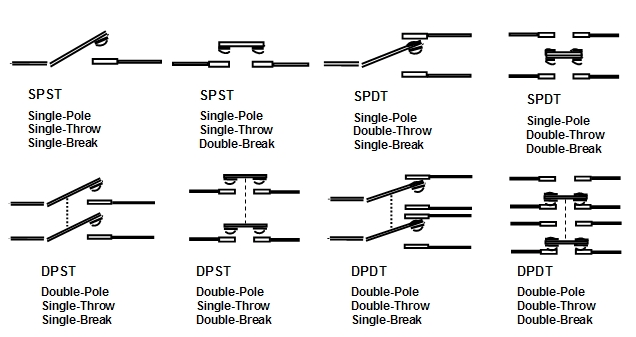Level Switches
Table of Contents
What are Level Switches?
A level switch is an instrument used to detect the level of a liquid, powder, or granulated material within a container. There are few different types of level switches, but they all serve the same purpose. When the conducting liquid reaches a certain height in the tank, a circuit is changed or completed and a signal is output which notifies the user of the liquid level. Level switches can be high-level or low-level [1]. Level switches are used in a large variety of applications such as oil tanks, washing machines, and wells [2].
Types of Level Switches
There are three main types of level switches. Other types of level switches also exist, but the three outlined below are most common.
- Float switch - The switch floats on top of the liquid and responds to the level moving up or down with an internal sensor in the switch. This sensor can complete a circuit to form an alert for the surface level of the tank.
- Capacitance switch - This works by having a probe hanging from a certain height into the tank, forming a two plate capacitor with the wall of the tank and the probe. When the level reaches the probe, the capacitance changes between the probe and the wall, due to the differing dielectric constant for the liquid compared to air. This triggers a change in the circuit, resulting in an alert for the changing level of liquid.
Vibrating switch - This works by utilizing two hanging vibrating prongs. When the liquid reaches the prongs, their frequencies change. The device senses this change and sends an alert [3].
Figure 1: A basic float switch [4] Figure 2: A capacitance level transmitter [5] Figure 3: A couple of different sizes of vibrating fork level sensors [6]
Design Specifications for Level Switches
Switch Type
- Electromechanical Switch - These switches have mechanical contacts and can handle a wide range of voltage and current. They are not affected by dirt or magnetic fields and can withstand up to 1000°C. These switches cost more than other types of switches, and do not last as long.
- Solid-State Switch - These switches do not have any moving parts in the assembly. They are able to respond much faster than an electromechanical switch.
Electrical Configuration
- Normally Open (NO) - These circuits become closed when a "contact" is made (when the level reaches the specified height).
- Normally Closed (NC) - These circuits are closed and current runs until the specified level is reached within the tank.
Pole/Throw
- Single Pole, Single Throw (SPST) - This circuit has a single conductor which is made or broken in a single branch circuit. They usually have two terminals.
- Single Pole, Double Throw (SPST) - This circuit has a single conductor which is made or broken with one or two single conductors. They usually have three terminals.
- Double Pole, Single Throw (SPST) - This circuit has two conductors which are made or broken in a single branch circuit. They usually have six terminals.
- Double Pole, Double Throw (SPST) - This circuit has two conductors whose connections are made or broken to two separate circuits. They usually have six terminals.
| Figure 4: The different types of pole/throw configurations [7] |
|---|
Communication Interface
Serial - This means the data bits are sent serially (one after the other) over a single line. The advantages of a serial interface are the data can be sent farther and they are easier to set up.
- Parallel - In this configuration, the data bits are all sent at the same time. More information can be sent quickly and reliably, but processing time is longer.
Measuring Range
This is the range of the level switch. The measuring range of the switch is determined by the maximum and minimum media levels in the tank or container. The overrange factor limits what the switch views as a match, so that when the level is way outside the range, it does not respond.
Mounting Styles
The switch can be top, side, or bottom mounted. Depending on the application and the characteristics of the level switch, this is a very important consideration.
Other Features
- Rated for sanitary applications
- Built in alarm (more than a switch)
- Programmable
- Controller functions [7]
Applications for Level Switches
Float Level Switches
Float switches are very commonly used for pump and valve controls. These switches can be used to open or close a pump, depending on the level in the tank. You can fill or drain the tank very easily with this setup. Another application is high and low level alarms. The float switch will detect the level in the tank or container and trigger an alarm or alarm message. This can prevent overfills for dangerous substances like oil. Float switches can also be used for immersion heater protection. It is important that the liquid in the heater stays above the heating element. If the level drops to the element, the switch can cut supply to the heater [8].
Capacitance Level Switches
Capacitance level switches are traditionally used in non-metallic applications. Common industries where capacitance level switches are used are plastics, chemical, wood, ceramic and glass, and packing industries.
Vibrating Level Switches
Vibrating rod level switches are commonly used with powders and bulk solids. They are great for applications with silos and hoppers. Some materials they can be used for include cereals, sugar, animal feed, flour, and wood chips [9].
Contributors:
| User | Last Update |
|---|---|
| Former user (Deleted) | 1139 days ago |
| Former user (Deleted) | 1141 days ago |
| Former user (Deleted) | 1201 days ago |


